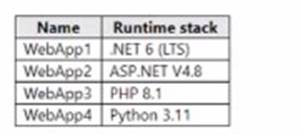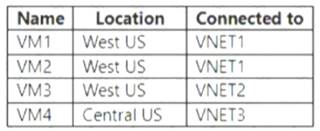- (Exam Topic 6)
You have an Azure subscription that contains a storage account named storage. You have the devices shown in the following table.
From which devices can you use AzCopy to copy data to storage1?
Correct Answer:
D
- (Exam Topic 6)
You have an Azure subscription. You need to transfer 34TB of data from an on-premise Windows 2016 server to your Azure storage account. You need to ensure that the data transfer has zero impact on the network, preserves your existing drives and is the fastest and most secure method. What should be your first step?
Correct Answer:
B
The Microsoft Azure Data Box cloud solution lets you send terabytes of data into and out of Azure in a quick, inexpensive, and reliable way.
https://docs.microsoft.com/en-us/azure/databox/data-box-overview
- (Exam Topic 3)
You need to configure the Device settings to meet the technical requirements and the user requirements. Which two settings should you modify? To answer, select the appropriate settings in the answer area.
Solution:
Box 1: Selected
Only selected users should be able to join devices
Box 2: Yes
Require Multi-Factor Auth to join devices. From scenario: Ensure that only users who are part of a group named Pilot can join devices to Azure AD
Ensure that only users who are part of a group named Pilot can join devices to Azure AD Ensure that when users join devices to Azure Active Directory (Azure AD), the users use a mobile phone to verify their identity.
Ensure that when users join devices to Azure Active Directory (Azure AD), the users use a mobile phone to verify their identity.
Does this meet the goal?
Correct Answer:
A
- (Exam Topic 6)
You have an on-premises network.
You have an Azure subscription that contains three virtual networks named VNET1, VNET2, and VNET3. The virtual networks are peered and connected to the on-premises network. The subscription contains the virtual machines shown in the following table.
You need to monitor connectivity between the virtual machines and the on-premises network by using Connection Monitor. What is the minimum number of connection monitors you should deploy?
Correct Answer:
B
- (Exam Topic 6)
You have an Azure App Service plan named AdatumASP1 that hosts several Azure web apps. You discover that the web apps respond slowly.
You need to provide additional memory and CPU resources to each instance of the web apps. What should you do?
Correct Answer:
D
References:
https://github.com/MicrosoftDocs/azure-docs/blob/master/articles/app-service/web-sites-scale.md Scale up : Correct Choice
Scale up: Get more CPU, memory, disk space, and extra features like dedicated virtual machines (VMs), custom domains and certificates, staging slots, autoscaling, and more. You scale up by changing the pricing tier of the App Service plan that your app belongs to.
Scale out : Incorrect Choice
Scale out: Increase the number of VM instances that run your app. You can scale out to as many as 30 instances, depending on your pricing tier. App Service Environments in Isolated tier further increases yo
scale-out count to 100 instances. For more information about scaling out, see Scale instance count manually or automatically.
Add continuous WebJobs : Incorrect Choice
WebJobs is a feature of Azure App Service that enables you to run a program or script in the same instance a a web app, API app, or mobile app. Add continuous WebJobs will Starts immediately when the WebJob is created. To keep the job from ending, the program or script typically does its work inside an endless loop. If
the job does end, you can restart it.Starts only when triggered manually or on a schedule.
Add a virtual machine scale set : Incorrect Choice
A virtual machine scale set allows you to deploy and manage a set of identical, autoscaling virtual machines.
You can scale the number of VMs in the scale set manually. You can also define rules to autoscale based on resource usage such as CPU, memory demand, or network traffic. It will not increase the slowness of the apps.
References:
https://docs.microsoft.com/en-us/azure/app-service/manage-scale-up https://docs.microsoft.com/en-us/azure/app-service/webjobs-create#webjob-types

